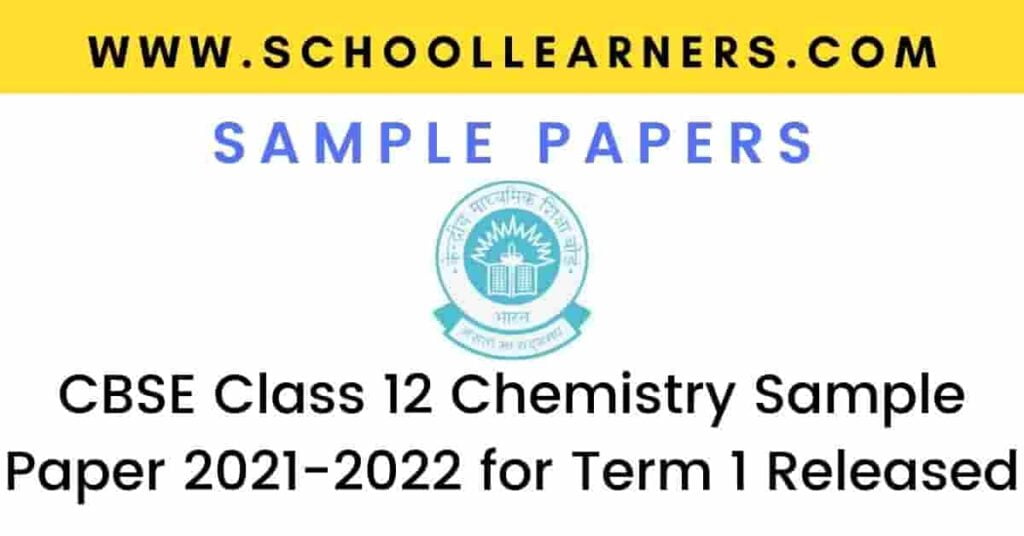CBSE Board Exams 2021-22: Class 10, 12 sample papers for Term I released CBSE Class 12 Chemistry Sample Paper 2021-2022 for Term 1 along with its marking scheme is provided here. Both are available for download in PDF so that students can access these important resources. The sample paper will help you to know how different types of MCQs will be asked in the paper. You will also get a rough idea of the difficulty level of the paper. With the CBSE Marking Scheme, you will be able to check the correct answers to all the questions. Practice all questions thoroughly to perform well in your CBSE 12 Chemistry Term 1 Exam 2021-2022.
CBSE Class 12 Chemistry Sample Paper 2021-2022 for Term 1 (with Answers): Download in PDF
General Instructions:
- The Question Paper contains three sections.
- Section A has 25 questions. Attempt any 20 questions.
- Section B has 24 questions. Attempt any 20 questions.
- Section C has 6 questions. Attempt any 5 questions.
- All questions carry equal marks.
- There is no negative marking.
SECTION A
This section consists of 25multiple choice questions with overall choice to attempt any 20 questions. In case more than desirable number of questions are attempted, ONLY first 20 will be considered for evaluation
1. Which of the following statements is true:
(a)Melting point of Phosphorous is less than that of Nitrogen
(b)N2 is highly reactive while P4 is inert
(c)Nitrogen shows higher tendency of catenation than P
(d)N-N is weaker than P-P
2. Which of the following is a non-stoichiometric defect?
(a)Frenkel defect
(b)Schottky defect
(c)metal deficiency defect
(d)interstitial defect
3. Identify the law which is stated as:
“For any solution, the partial vapour pressure of each volatile component in the solution is
directly proportional to its mole fraction.”
(a)Henry’s law
(b) Raoult’s law
(c)Dalton’s law
(d)Gay-Lussac’s Law
4. Pink colour of LiCl crystals is due to:
(a) Schottky defect
(b)Frenkel defect
(c) Metal excess defect
(d) Metal deficiency defect
5. Which of the following isomer has the highest meltingpoint:
(a) 1,2-dicholorbenzene
(b) 1,3 -dichlorobenzene
(c) 1,4-dicholorbenzene
(d) all isomers have same melting points
6. Which one of the following reactions is not explained by the open chain Structureof glucose:
(a) Formation of pentaacetate of glucose with acetic anhydride.
(b) formation of addition product with 2,4 DNP reagent
(c) Silver mirror formation with Tollen’s reagent
(d) existence of alpha and beta forms of glucose.
7. Williamson’s synthesis of preparing dimethyl ether is an:
(a) SN1 reaction
(b) Elimination reaction
(c) SN2 reaction
(d) Nucleophilic addition reaction
8. Chlorine water loses its yellow colour on standing because:
(a) HCl gas is produced, due to the action of sunlight.
(b) a mixture of HOCl and HCl is produced in the presence of light
(c) HOCl and hydrogen gas is produced
(d) a mixture of HCl and ClO3 is produced, due to the action of sunlight
9. During dehydration of alcohols to alkenes by heating with concentrated H2SO4, the initiation step is:
(a) protonation of alcohol molecule
(b) formation of carbocation
(c) elimination of water
(d) formation of an ester
10. Amorphous solids are:
(a) isotropic
(b)anisotropic
(c) isotopic
(d) isomeric
11. Which of the following reactions is used to prepare salicylaldehyde?
(a) Kolbe’s reaction
(b) Etard reaction
(c) Reimer- Tiemann reaction
(d) Stephen’s reduction.
12. Which of the following is an example of a solid solution?
(a)sea water
(b)sugar solution
(c)smoke
(d)22 carat gold
13. The boiling points of alcohols are higher than those of hydrocarbons of comparable masses due to:
(a) Hydrogen bonding
( b) Ion – dipole interaction
(c) Dipole- dipole interaction
(d) Van der Waal’s forces.
14. Which of the following has the lowest boiling point:
(a)H2O
(b)H2S
(c)H2Se
(d)H2Te
15. Which of the following statement is correct:
(a)Fibrous proteins are generally soluble in water
(b)Albumin is an example of fibrous proteins
(c)In fibrous proteins, the structure is stabilised by hydrogen bonds and disulphide bonds
(d)pH does not affect the primary structure of protein.
16. Major product obtained on reaction of 3-Phenyl propene with HBr in presence of organic peroxide
(a)3- Phenyl 1- bromopropane
(b) 1 –Phenyl -3- bromopropane
(c) 1-Phenyl -2-bromopropane
(d) 3-Phenyl -2- bromopropane
17. Which of the following is a correct statement for C2H5Br?
(a) It reacts with metallic Na to give ethane.
(b) It gives nitroethane on heating with aqueous solution of AgNO2
(c) It gives C2H5OH on boiling with alcoholic potash.
(d) It forms diethylthioether on heating with alcoholic KSH.
18. Covalency of nitrogen is restricted to:
(a)2
(b)3
(c)4
(d)5
19. Solubility of gases in liquids decreases with rise in temperature because dissolution is an:
(a)endothermic and reversible process
(b)exothermic and reversible process
(c)endothermic and irreversible process
(d) exothermic and irreversible process
20. All elements of Group 15 show allotropy except:
(a)Nitrogen
(b)Arsenic
(c)Antimony
(d)Bismuth
Download the full sample paper from the link mentioned below:
CBSE Class 12 Chemistry Sample Paper 2021-2022 for Term 1
| CBSE Class 12 Chemistry | Term 1 Sample Paper | Marking Scheme |
